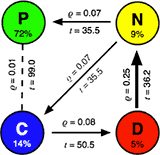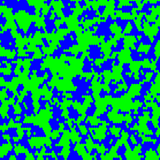Tutorials
Introduction

Quick introduction covering the basic ideas of evolutionary game theory illustrated with many examples. This section briefly introduces classic games such as the Prisoner's Dilemma, the Hawk-Dove- or Snowdrift game and the Rock-Scissors-Paper game. It is intended as an overview of the many features and capabilities of the interactive EvoLudo simulator.
Via freedom to coercion: the emergence of costly punishment

Tutorial on the role of voluntary participation in joint effort games for the evolution of costly punishing behavior. The freedom to withdraw from common enterprises leads to the enforcement of social norms. Joint enterprises which are compulsory rather than voluntary are less likely to lead to cooperation.
Evolutionary games and population dynamics

Tutorial on frequency dependent selection in populations of varying size. The classic replicator dynamics assumes constant (infinite) population sizes and thus neglects the ecology of the population. Linking ecological dynamics and evolutionary games generates fascinating and rich dynamical behavior. Most importantly, however, this reveals a new mechanism for maintaining cooperation through negative feedback between population densities and the size of interaction groups.
Hauert, Ch., Wakano, J. Y. & Doebeli, M. (2008) Theor. Pop. Biol. 73, 257-263.
Synergy & discounting of cooperation in social dilemmas

Tutorial on cooperation in social dilemmas. Social dilemmas are characterized by a conflict of interest between the individuals and the group. The most prominent examples of social dilemmas are the prisoner's dilemma, the snowdrift game and public goods game. Based on the concept of synergistic or discounted accumulation of cooperative benefits we present a unifying framework to model cooperation in social dilemmas.
Hauert, C. (2006) J. theor. Biol. 240, 627-636.
Origin of cooperators and defectors

Tutorial on the gradual evolution of distinct cooperative and defective behavioral patterns through evolutionary branching into separate trait groups characterized by high and low cooperative investments. This is based on a model that extends the classical Snowdrift game to continuously varying degrees of cooperation. Apart from evolutionary branching, this model exhibits rich dynamics that can be easily explored using this interactive tutorial.
Evolutionary dynamics on graphs

Tutorial on the fixation probability of mutants in structured populations where individuals are arranged on a graph. For a large class of graphs, the fixation probability does not depend on the details of the population structure and is identical to a homogenous population. All these graphs display the same characteristic balance between evolutionary selection and random drift. Nevertheless, the structure of the graph can have significant effects on the fixation probability ranging from complete suppression of selection to guaranteed fixation of advantageous mutants.
Ohtsuki, H., Hauert, C., Lieberman, E. & Nowak, M. (2006) Nature 441, 502-505.
Cooperation in structured populations

Tutorial on the fate of cooperative behavior in two closely related evolutionary games: the Prisoner's Dilemma and the Snowdrift (Hawk-Dove) game. The population structure then determines whether the evolution and maintenance of cooperation is promoted or hindered. In particular, this interactive tutorial illustrates that, in contrast to the Prisoner's Dilemma, spatial structure can be detrimental to cooperation in the Snowdrift game.
Voluntary Public Goods Games

Tutorial on voluntary participation in public goods games. Most of the literature on cooperation in social dilemmas assumes that interactions are compulsory. In most real-life situations, however, individuals may choose to opt out whenever a public enterprise appears too risky. This results in a rock-scissors-paper type dominance of cooperators, defectors and loners (those that do not participate). Volunteering can maintain cooperation in mixed populations and results in fascinating spatio-temporal patterns in spatial settings.
Hauert, C., De Monte, S., Hofbauer, J. & Sigmund, K. (2002) J. theor. Biol. 218 187-194.
Public goods games

Tutorial on public goods games in populations with different structures. Public goods games essentially represent a generalization of the pairwise prisoner's dilemma interactions to groups of arbitrary size. In spatially extended populations, where individuals interact within a limited local neighborhood, cooperators can persist through cluster formation. Variations of the value of the public good result in a critical phase transition which relates to percolation phenomena from condensed matter physics.
Reward, punishment and reputation

Tutorial on effects of reward, punishment and reputation in Public Goods games. Various experimental studies on social dilemmas have shown that punishment is very efficient in creating incentives for cooperative behavior. Reward, however, is considerably less efficient. The underlying mechanisms are illustrated with a simple game theoretical model.
Brandt, H., Hauert, C. & Sigmund, K. (2003) Proc. R. Soc. Lond. B 270, 1099-1104.
2×2 games
Tutorial on 2×2 games in populations with different structures. 2×2 games describe a rich set of pairwise interactions among individuals. The most prominent game is certainly the Prisoner's Dilemma which has become the paradigm to discuss the emergence of cooperative behavior. If players are arranged on regular lattices, many of these games produce fascinating spatio-temporal patterns. This tutorial provides a hands-on experience of this dynamical world.
